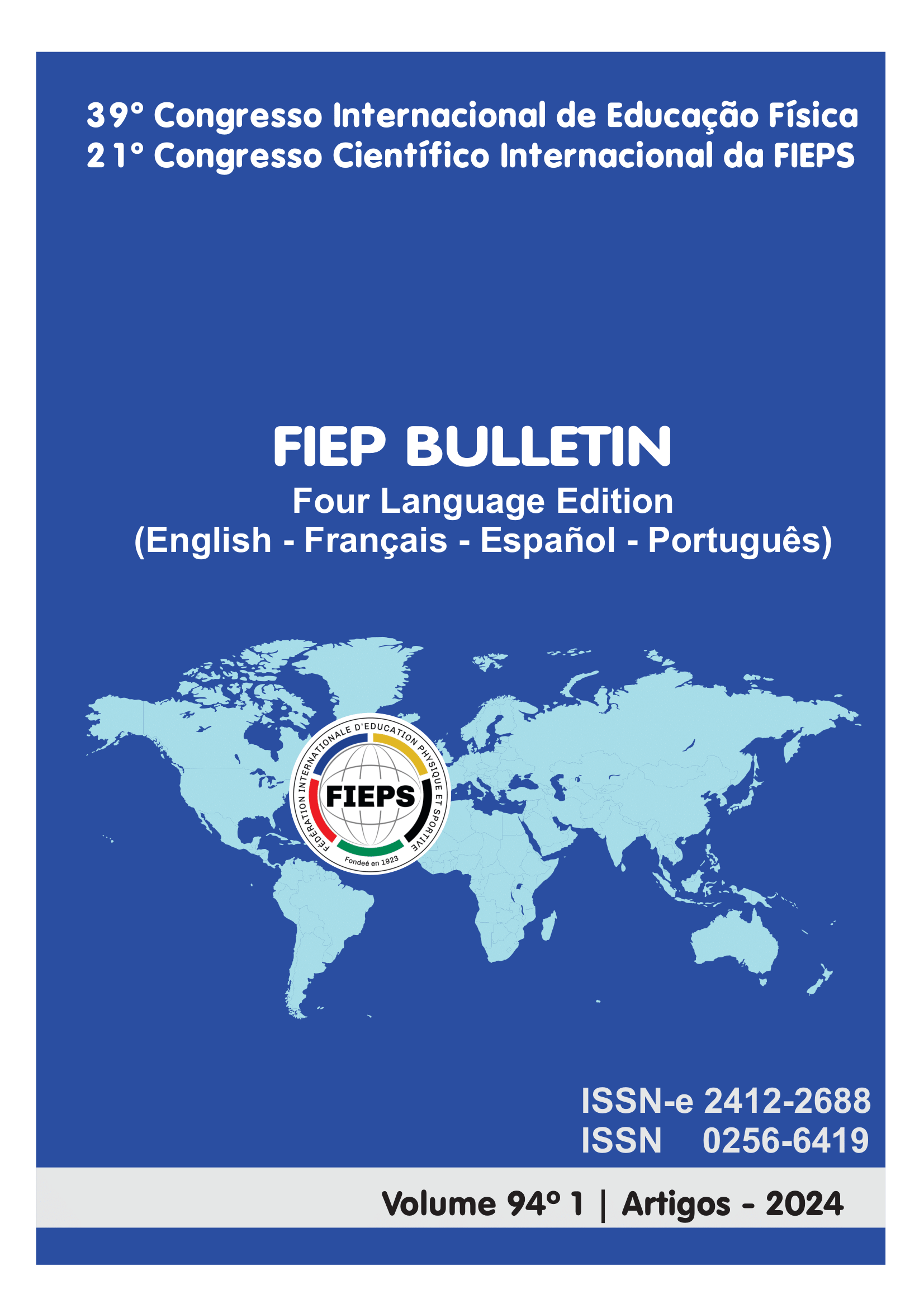LA ACTIVIDAD FÍSICA Y SU IMPACTO EN LA CONDUCTA SOCIAL
DOI:
https://doi.org/10.16887/fiepbulletin.v94i1.6706Keywords:
Sedentarismo, estilo de vida saludable, Conductas SocialesAbstract
Introduction: Physical activity and sport provide psychosocial benefits, improve mood, ability to concentrate and favor the integration of communities, therefore it is important to assess whether sedentary behaviors and lack of physical activity are determined by sociodemographic factors Lavielle-Sotomayor , et al (2014).Objective: Implement the permanent practice of physical activity as a strategy to have an impact on the social fabric. Methods: Type of mixed, correlational and longitudinal research; Where 285 subjects from the Rio Dorado housing unit in Durango Durango participated, (154 men and 231 women) from 8 to 20 years of age, where the exclusion factors were not being an inhabitant of the housing unit or not attending more than 80% to the activities (June to December 2021). Having as main. Results: According to the perception of the subjects, it was evidenced that they have experienced better self-esteem, decreased stress and physical discomfort, better social, neighbor and family relationships, a greater sense of belonging to their community and enjoyment of life, and that they have improved their practices of self care. Conclusion: the practice of physical activity on a permanent basis contributes to a better quality of life, as well as a greater sense of belonging and coexistence in the housing unit.
Keywords: Activity Tracker, Healthy Lifestyle, Sociality.
Downloads
References
Berra, S., Bustingorry, V., Henze, C., Díaz, M. D. P., Rajmil, L., & Butinof, M. (2009). Adaptación transcultural del cuestionario KIDSCREEN para medir calidad de vida relacionada con la salud en población argentina de 8 a 18 años. Archivos argentinos de pediatría, 107(4), 307-314.
Cascales, J. Á. M., & Prieto, M. J. R. (2019). Incidencia de la práctica de actividad física y deportiva como reguladora de la violencia escolar. Retos: nuevas tendencias en educación física, deporte y recreación, (35), 54-60. DOI: https://doi.org/10.47197/retos.v0i35.64359
Devís Devís, J., Pérez Samaniego, V., & i Esportiva, D. D. E. F. (2018). La actividad física y el deporte en personas trans: la participación, los motivos y los factores socioecológicos.
Gusqui, I. M. G., Ramírez, K. M. V., Morocho, M. J. D., Castillo, K. I. A., Armijos, R. E. S., & Jiménez, H. M. C. (2019). Comprendiendo la evaluación de la actividad física: revisión de los conceptos y métodos actuales. Revista Latinoamericana de Hipertensión, 14(2), 237-242. http://www.revhipertension.com/rlh_2_2019/comprendiendo_evaluacio n_actividad.pdf
Lavielle-Sotomayor, P., Pineda-Aquino, V., Jáuregui-Jiménez, O., & Castillo-Trejo, M. (2014). Actividad física y sedentarismo: Determinantes sociodemográficos, familiares y su impacto en la salud del adolescente. Revista de salud pública, 16, 161-172.. DOI: https://doi.org/10.15446/rsap.v16n2.33329
Mahecha Loaiza, M. A. (2019). Contribuciones de encuentro recreativos a la reconstrucción de tejido social y participación de la niñez victima del conflicto armado del municipio de sibaté (Doctoral dissertation).
Molina, T., Montaño, R., González, E., Sepúlveda, R., Hidalgo-Rasmussen, C., Martínez, V., ... & George, M. (2014). Propiedades psicométricas del cuestionario de calidad de vida relacionada con la salud KIDSCREEN-27 en adolescentes chilenos. Revista médica de Chile, 142(11), 1415-1421. DOI: https://doi.org/10.4067/S0034-98872014001100008
Muñoz Zapata, A. P., & Castaño, L. C. (2013). La empatía: ¿un concepto unívoco? 16, pp. 123-143.Envigado, Colombia.
Murcia, E. I. T. (2010). El sentido del tejido social en la construcción de comunidad. Polisemia, 6(10), 9-23. DOI: https://doi.org/10.26620/uniminuto.polisemia.6.10.2010.9-23
Rascón MT. La importancia de las redes de apoyo en el proceso resiliente del colectivo inmigrante. Dedica. Revista de educação e humanidades, 2017; V. (11) março, 61-82
Ravens-Sieberer, U., Gosch, A., Rajmil, L., Erhart, M., Bruil, J., Duer, W., ... & KIDSCREEN Group, E. (2005). KIDSCREEN-52 quality-of-life measure for children and adolescents. Expert review of pharmacoeconomics & outcomes research, 5(3), 353-364. DOI: https://doi.org/10.1586/14737167.5.3.353
Rodríguez Vela, B. R., Tapia Martínez J.R., Rodríguez Vela, M.A. (2020). Actívate en Cinco. Editorial Académica Española.
Romero K, Conde E, Muñoz I. (2017). La Actividad Física y la Salud Mental en la adolescencia. Calidad de vida, inclusión social y bienestar humano, 77. DOI: https://doi.org/10.21892/9789804270215.5
Sampieri, R. H. (2018). Metodología de la investigación: las rutas cuantitativa, cualitativa y mixta. McGraw Hill.
Vargas, Miguel Ángel y Rosas, Mónica Estefani. Impacto de un programa de actividad física aeróbica en adultos mayores con hipertensión arterial. Revista Latinoamericana de Hipertensión. Vol.14-2,2019 http://www.revhi pertension.com/rlh_2_2019/impacto_programa_actividad.pdf
Downloads
Published
How to Cite
Issue
Section
License
Autores que publicam nesta revista concordam com os seguintes termos:- Autores mantém os direitos autorais e concedem à revista o direito de primeira publicação, com o trabalho simultaneamente licenciado sob a Licença Creative Commons Attribution que permite o compartilhamento do trabalho com reconhecimento da autoria e publicação inicial nesta revista.
- Autores têm autorização para assumir contratos adicionais separadamente, para distribuição não-exclusiva da versão do trabalho publicada nesta revista (ex.: publicar em repositório institucional ou como capítulo de livro), com reconhecimento de autoria e publicação inicial nesta revista.
- Autores têm permissão e são estimulados a publicar e distribuir seu trabalho online (ex.: em repositórios institucionais ou na sua página pessoal) a qualquer ponto antes ou durante o processo editorial, já que isso pode gerar alterações produtivas, bem como aumentar o impacto e a citação do trabalho publicado (Veja O Efeito do Acesso Livre).









